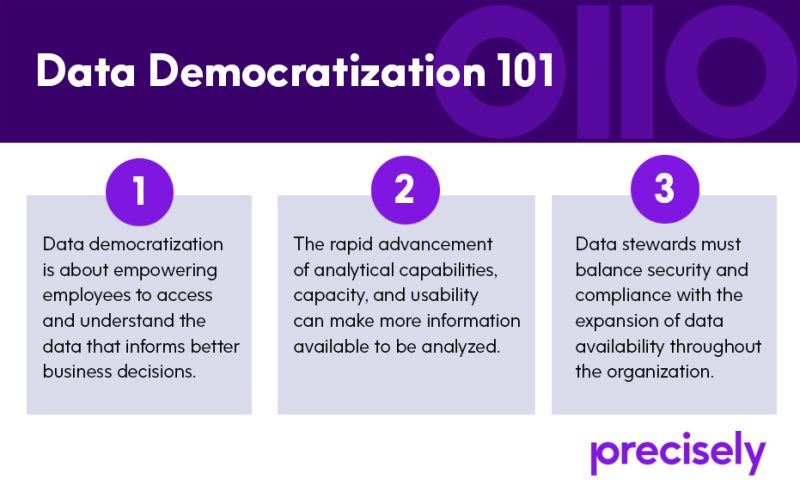
Data Democratization 101

Key Takeaways:
- Data democratization is about empowering employees to access and understand the data that informs better business decisions.
- The rapid advancement of analytical capabilities, capacity, and usability can make more information available to be analyzed.
- Data stewards must balance security and compliance with the expansion of data availability throughout the organization.

The goal of data democratization is to enable a free flow of information that powers business agility – allowing anyone in an organization to access and use data to make informed decisions without barriers. When data is made widely available across departments, it can drive innovation and operational excellence. For example, manufacturing companies are using shared production data across supply chain, engineering, and finance teams to optimize operations and reduce costs. Retailers have leveraged democratized data to provide real-time insights from inventory, marketing, and customer behavior, improving sales performance and enhancing the customer experience.
Of course, not all value derived from data sharing is pre-planned. Often, unexpected insights emerge when data is available to broader teams. Financial services firms, for instance, have discovered that sharing market and customer data across product teams leads to the development of new financial products and services. In the technology sector, companies that make data accessible to cross-functional teams have enabled faster innovation cycles, identifying new market opportunities and improving product features based on data-driven insights.
Many enterprises recognize the benefits of making data more broadly available within their organizations. This process of data democratization means that people throughout the business can access a larger data pool and analytics toolset. They can ask questions and get meaningful data-driven answers. With data democratization, the availability of data and associated analysis tools extends far beyond the limited group of experts who have a data science background.
Organizations are evaluating modern data management architectures that will support wider data democratization. Two approaches that have gained traction are that empowers domain experts to create, manage, and share data products – and that unifies AI/ML analysis of metadata across complex ecosystems to provide visibility into data products, as well broader data management enhancements.
Why data democratization matters
First and foremost, data democratization is about empowering employees to access the data that informs better business decisions. When access to data is limited to a select few, it limits an organization’s ability to ask questions, elicit insights from the data, and apply those insights to the creation of business value.
In addition to driving good business decisions, data democratization also provides for a better customer experience.
In this age of the omnichannel, consumers expect businesses to have a complete picture of their:
- past purchases
- touch points with company personnel
- and even their demographics.
If their experience with a company seems disjointed, many are prone to take their business elsewhere.
Read our eBook
Managing Risk & Compliance in the Age of Data Democratization
This eBook describes a new approach to achieve the goal of making the data accessible within the organization while ensuring that proper governance is in place.
Data democracy: Why now?
Data democratization has become a hot topic lately with advances in technology such as AI and machine learning, cloud storage and scalable server capacity, and improved integration. Then add self-service business intelligence tools that are accessible to virtually anyone. The net result has been a rapid advancement of analytical capabilities, capacity, and usability.
Combine that with the advent of location-aware mobile devices, IoT sensors, digital marketing automation, and ever-increasing volumes of unstructured data, there is so much more information available to be analyzed.
Limitations and concerns
There are some caveats around data democratization that business leaders need to understand. First, there is the question of security. Every organization has measures in place to prevent employees and outside parties from unauthorized access to information. When people start talking about making company data more widely available, it naturally raises questions about how much is too much, who should have access, and what the appropriate level of granularity is for any given dataset.
The same kinds of issues arise around compliance. Companies are already struggling to comply with GDPR, CCPA/CCRA, HIPAA, and a host of other data privacy and security regulations. When considering data democratization, business leaders need to clearly understand downstream compliance implications.
Concerns may also arise around duplication of effort and unintentional misuse of data. In other words, if every department is doing its own work around data analysis, some of that work may be redundant. In the wrong hands, data may be misinterpreted, which can lead to faulty conclusions and poor business decisions.
These concerns can be addressed by building transparency, governance, and quality control into the data democratization model, allowing departments to explore new ways to extract value from data while limiting duplication of effort and reining in misuse.

The path forward to data democratization
Data democratization begins with a clear understanding of its potential value across the organization. This requires a holistic and comprehensive strategy that broadens enterprise data access, rather than a piecemeal project-based approach.
When analytics initiatives are treated as one-off projects, integration and data governance often suffer as they are tailored to the needs of a specific project on a case-by-case basis. This leads to a “just get it done” mentality that serves the need at hand but fails to address the longer term requirements of a broader audience. A better approach is to build a data governance structure that will outlast the immediate needs driven by any specific project.
Data stewards must also balance security and compliance with the expansion of data availability throughout the organization. Ultimately, the goal is to do both, but clearly security and compliance are not negotiable. Once again, good data governance provides the framework in which organizations can achieve both objectives.
Data democratization is ultimately driven by a three-part equation comprised of:
- Simplicity means that the producers of data have clearly understood targets for the structure and quality of the data they create, manage, and provision, while consumers of that information know how they can access it and what they can or cannot expect to learn from it.
- Scalability is achieved by limiting the proliferation of integration points, streamlining the flow of information for timely results, and deploying smart strategies such as business-friendly data catalog or marketplace where applicable.
- Attention to data quality. Data stewards must address the problem of “garbage in, garbage out.” Data quality demands that information be consistent, complete, accurate, and timely. As the volume of information managed by today’s enterprises continues to grow, data quality demands even greater attention.
Precisely is a global leader in data integration, data governance/quality, data observability & data enrichment, we offer best-in-class tools and expertise to help companies achieve excellence in enterprise integration and data management.
To learn more about how your organization can get data democratization. Read our eBook Managing Risk & Compliance in the Age of Data Democratization, which describes a new approach to achieve the goal of making the data accessible within the organization while ensuring that proper governance is in place.


